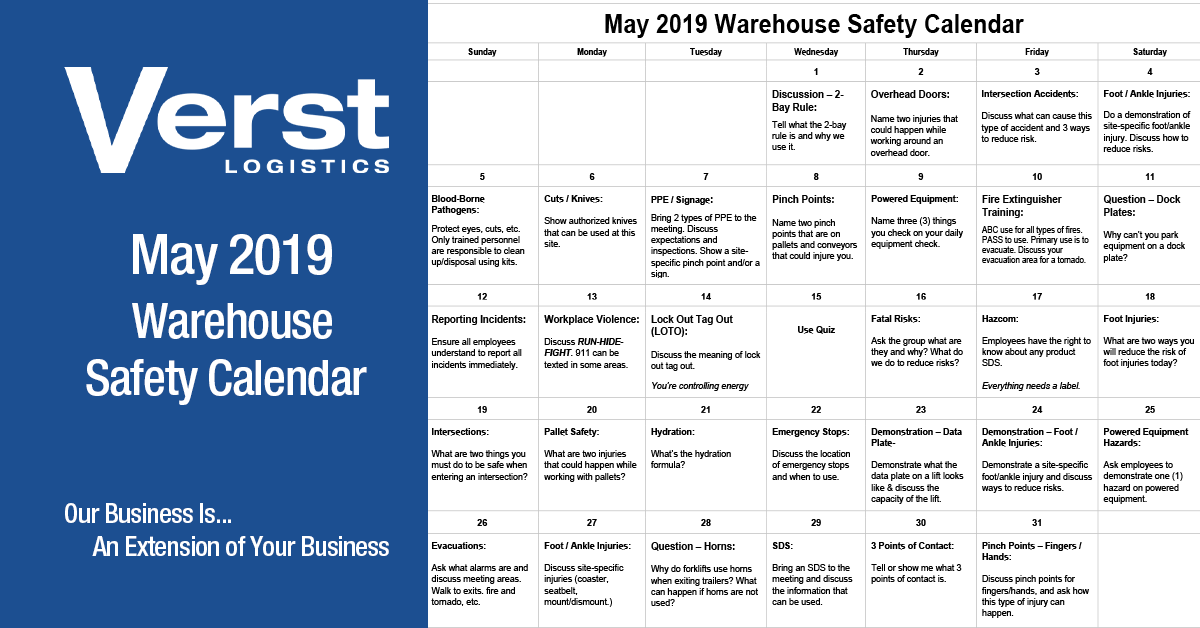
July 2, 2019
Warehouses are statistically one of the most dangerous places to work, and the added tasks of operating heavy machinery and transporting large objects do not make it safer. In 2017, there were approximately 209,000 non-fatal occupational injuries in the transportation and warehousing industry in the private sector according to the U.S. Bureau of Labor. The even bigger number is the days away from work that still costs company's money when the employee isn't present. In 2017 alone, there were over 20,000 days away from work related to injuries by warehouse workers.
Download the safety calendar here: July 2019 Warehouse Safety Calendar
Warehouse injuries are extremely expensive, and needless to say because of this, warehouse safety is extremely

important. The even bigger reason to focus on safety is the well-being of your employees - they need to come first. There are many things you can do to avoid workplace accidents and to maintain a safe workplace for your employees and the environment. It is important to establish a proper safety protocol, conduct regular safety training, follow long-term and short-term housekeeping procedures, and have the proper safety products and equipment.
Please use this monthly safety calendar to go over topics with your employees that will allow your managers to establish proper warehouse safety protocol and conduct regular daily and monthly warehouse safety training schedules.
Please use our monthly warehouse safety calendar below as a guide for your safety meetings
July 2019 Warehouse Safety Calendar |
||||||
| Sunday | Monday | Tuesday | Wednesday | Thursday | Friday | Saturday |
| 1 | 2 | 3 | 4 | 5 | 6 | |
|
|
Question – Hydration: Where do you find a hydration chart? |
Discussion: What are two signs that you need to drink some water? |
Running Lines: Ensure employees understand rule & reasons why all body parts should be in the running lines of equipment. |
Demonstration: Focus on intersections and the task at hand. |
Seat Belts: Why do you wear a seatbelt? Wait for 2 different answers. |
Foot / Ankle Injuries: Ask about foot/ankle injuries. How can they happen at your site? How can we prevent them? |
| 7 | 8 | 9 | 10 | 11 | 12 | 13 |
|
Question: When power is lost in the facility and you are on equipment what should you do? |
Harassment: Review the anti-harassment policy. It is not tolerated and will be investigated. Report this immediately! |
Running Lines: Ensure employees understand rule & reasons why all body parts should be in the running lines of equipment. |
Discussion: Discuss the importance of allowing eyes to adjust when entering a building from outside. Going from bright to dark area. |
Demonstration: When lifting overhead, keep elbows in not out. Remember to ask for help when needed. |
Knife Safety / Cuts: Ask an EE for a Safety Knife. Explain the difference between an authorized and unauthorized knife. Discuss cuts. |
Running Lines: Discuss having all body’s parts in the running lines of equipment and why it’s important. |
| 14 | 15 | 16 | 17 | 18 | 19 | 20 |
|
Seat Belts: Ask why do you wear seatbelts and why you can’t tie a knot in a seatbelt. |
Site-Specific Hazards: What hazards are in your area and how can we reduce them? |
Intersection Safety: Go to an aisle or intersection and talk about incidents. What needs to be done to achieve ALARP? |
Use Test |
Equipment Checks: Have pallet jack or forklift at pre shift, have someone demonstrate the proper way to complete equipment checklist on it. |
Crosswalk/ Parking Lot Safety: Phones kept down and heads kept up. |
Discussion: Discuss fire exits and locations of extinguishers. Go over PASS: Pull, Aim, Squeeze, Sweep. |
| 21 | 22 | 23 | 24 | 25 | 26 | 27 |
|
Discussion: Ask what the first and second questions of SLAM are and have EE give an example. |
Fatal Risks: Ask what is Lockout/Tagout used for? The controlling of energy. |
Pinch Points: Discuss pinch points at your meeting and ask EE’s to give two examples. |
Discussion: Ask what are some signs of heat stroke? Hot red or flushed dry skin, confusion, and disorientation. |
Discussion: Talk about overhead door injuries and how to reduce the risks. |
Hydration: Name 2 signs of dehydration. |
Knife Safety / Cuts: Ask an EE for a Safety Knife. Explain the difference between an authorized and unauthorized knife. Discuss cuts. |
| 28 | 29 | 30 | 31 | |||
|
Pallet Safety: Bring a pallet to the meeting and ask for three hazards and how to reduce risks. |
Oil Spills: Ask where the outside drains are located? What is and where do we keep Speedy Dry? |
Question – Horns: Why do forklifts use horns when exiting trailers? What can happen if horns are not used? |
Fatal Risks: Discuss the 3 points of protection that we have at dock doors: Chocks, Dock locks, cones, dock lights, pull tickets, etc. |
|||
Tags:

Warehouses are statistically one of the most dangerous places to work, and the added tasks of operating heavy machinery and transporting large objects do not make it safer. In 2017, there were...
Resources
Connect